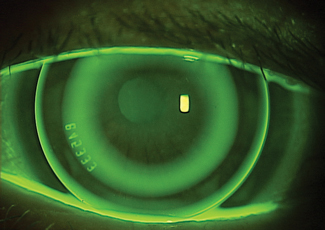 |
| A recent study on ortho-K lenses found that changes in subfoveal choroidal thickness was unaffected by the treatment zone size over time and therefore had a limited effect on axial elongation. Photo: Robert Ensley, OD, and Heidi Miller, OD. Click images to enlarge. |
Many have proposed that a smaller treatment zone size, produced by an orthokeratology (ortho-K) lens with a smaller back optic zone diameter (BOZD), is thought to create more dramatic changes (both optical and morphological) within the central cornea, and allow a larger area of the peripheral retina to experience the myopic defocus caused by the corneal steepening ring, which may result in better myopia control. Researchers in China compared axial elongation and treatment zone characteristics in children wearing either 6mm or 5mm BOZD ortho-K lenses over two years. The team found that lenses with smaller BOZD can create a smaller treatment diameter, resulting in less axial elongation. The most dramatic changes for treatment zone diameter, choroidal thickness thickening and axial elongation occurred during the first six months. Nevertheless, smaller BOZD ortho-K lenses neither affected visual performance nor caused significant visual sign/symptoms in children wearing them, compared with conventional construction.
The study randomly assigned six to 11 years old myopic (-4.00D to -0.75D) children of Chinese ethnicity to use the two different lens designs. Data collection was performed at baseline and every six months after commencing lens wear.
After 24 months, the 22 participants wearing lenses with a 5mm BOZD achieved smaller treatment zone diameter (horizontal: 2.69mm vs. 3.84mm; vertical: 2.65mm vs. 3.42mm and less axial elongation (0.15mm vs. 0.35mm) compared with the group of 23 using the 6mm design, with no difference in choroidal thickness changes. A significant increase in choroidal thickness, using pooled data analysis, was noted at the six-month (11.8μm) and 12-month (12.0μm) visits, compared with the baseline. The researchers pointed out that this indicated a transient change in thickness. Significant associations were determined, using linear mixed models, between axial elongation and the treatment zone diameters after adjusting for baseline data. A very weak association was found between choroidal thickness changes and axial elongation, with the effect size close to zero. No cases of microbial keratitis were observed during the two-year study.
The researchers proposed that the smaller BOZD lenses’ effect on axial elongation could occur mainly during the first six months due to the stabilized treatment zone diameter.
“Compared with conventional 6mm BOZD lenses, the 5mm BOZD lenses achieved similar clinical performance (about 0.20 mm smaller) without affecting ocular integrity,” they concluded in their paper. “However, choroidal thickness changes did not play a significant role in slowing axial elongation.”
Guo B, Cheung SW, Kojima R, Cho P. Variation of Orthokeratology Lens Treatment Zone (VOLTZ) Study: a two-year randomized clinical trial. Ophthalmic Physiol Opt. August 6, 2023. [Epub ahead of print]. |

